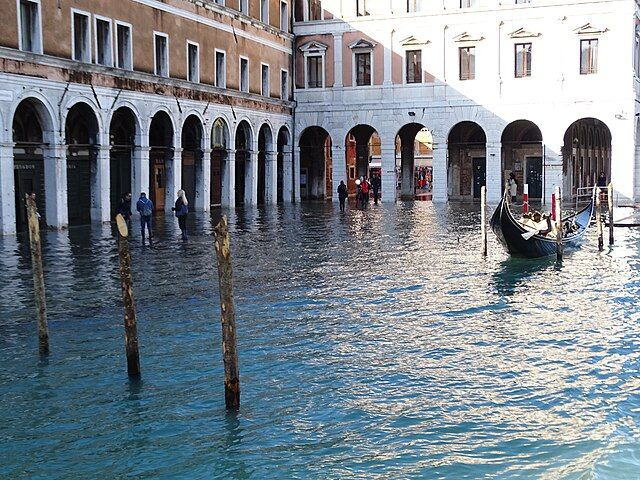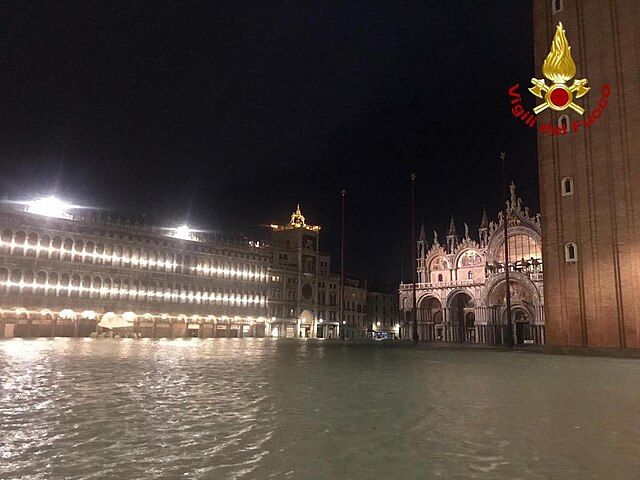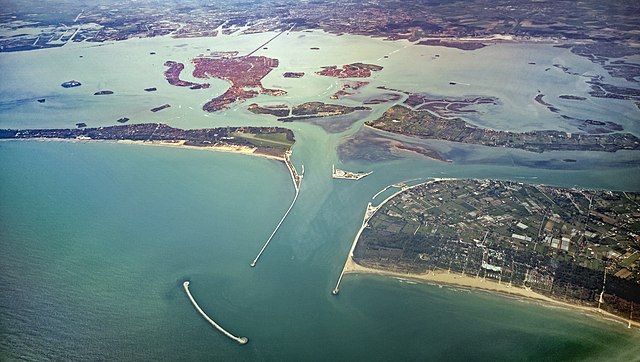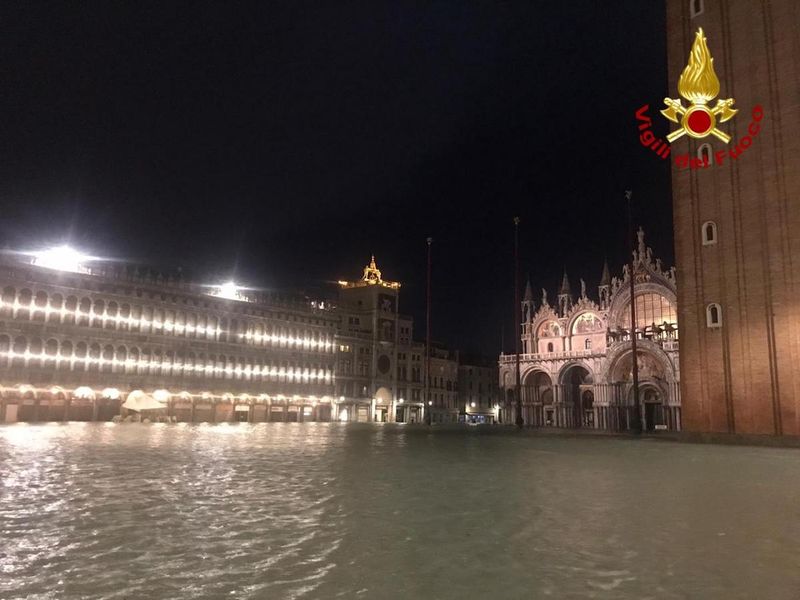Hey travelers! Today we’re taking you to Venice, a city that charms with its history, its canals and, unfortunately, its tides. We’re going back in time to 12th November 2019 to remember an extraordinary and devastating event: the acqua Granda Venice, not the acqua alta.
Five years on, let’s relive what happened that day and find out why the high tide in Venice is still a reality, an emergency and a challenge for the Serenissima.
In this guide we’ll tell you everything you need to know about the acqua granda in Venice, from the causes to the details of that day, to the measures the Serenissima has taken to protect itself from future events like this.
Acqua granda Venice 12th November 2019 5 years ago

If you love Venice or you’re planning a trip to this city suspended between history and water, you must know one of the events that has deeply marked its recent past: the acqua granda in Venice 12th November 2019.
This event entered the history books as one of the worst tides ever, that hit Venice exactly 5 years ago. But let’s dive into what you need to know about the acqua granda Venice 12th November 2019.
What happened 5 years ago on 12th November 2019 in Italy: the acqua granda in Venice

12th November 2019 is a date carved in the collective memory of Venice. A massive tide, fueled by strong winds and high tide, flooded the city, reaching historic high water levels. The event, called acqua granda, reached an impressive 187 cm, making 2019 one of the most critical years in the recent history of the city after 1966.
The 12th November 2019 tide flooded over 80% of the urban area, including some of the symbols of Venice, such as St. Mark’s Square, where the water reached unimaginable levels, damaging historic buildings and artworks. Acqua granda Venice means more than just “high water”, it’s the power of nature that, in one day, put Venice and its inhabitants to the test.
This disaster, second only to the 1966 flood, has caused irreparable damage to historic monuments, homes, businesses and streets.
The event was caused by a combination of extreme meteorological events. Strong scirocco winds pushed a lot of water into the venetian Lagoon, amplifying the already high November tides. The result was a dramatic impact, with estimated damages in billions of euros. Many Venetians called that day a nightmare, while the world watched in horror and concern.
The city of Venice response
The Venetians response to the acqua granda was a perfect example of resilience. As the water rose, residents rolled up their sleeves to protect their workplaces, homes and historic assets. After the emergency many organizations and private citizens launched initiatives to recover and fund-raising to face the damage.
The images of St. Mark’s Square flooded are all over the world media, raising public awareness on the fragile balance of Venice, a city so precious and so vulnerable.
What to know about the acqua granda Venice 12th November 2019: the details
That evening of November, the water flooded squares, churches and museums, but the most severe damage hit St. Mark’s Basilica where the water reached never seen before levels, damaging precious mosaics and ancient marble structures. The famous Rialto Bridge and many businesses, especially in the historical center, were also severely damaged.
The MOSE, a movable barriers system designed to protect Venice from high tides, was under construction but not yet operational. This tragedy has accelerated the implementation of the barriers, a huge engineering work, but also a controversial one, not only for the delays and costs, but also for the doubts on its real effectiveness.
But to fully understand what happened during the 2019 Venice acqua granda, it’s important to go into the details of that disaster. The tide started to rise in the afternoon but no one could have predicted it would reach such a high level. Initially the forecast was for a tide of about 140 cm, but the strong scirocco winds increased the pressure on the Adriatic sea and the result was a never seen before surge.
The main damages of the acqua granda Venice
The high tide of Venice is a known phenomenon for the Venetians, but the 2019 level was devastating. Here are the main damages:
- Historical buildings damaged: places like St. Mark’s Basilica and its crypt were severely damaged, with water infiltrations that compromised artworks, mosaics and ancient structures.
- Businesses: many shops, restaurants and bars were flooded, causing huge economic losses for those who live and work in the city.
- Private homes: hundreds of ground floor homes were invaded by water, forcing many families to leave their homes temporarily.
The losses
The 2019 Venice acqua granda has caused damages estimated in hundreds of millions of euros. The losses were huge for shopkeepers, restaurateurs and residents who had to face also the costs to repair and restore the damaged structures.
What is acqua granda in Venice?
To be exact, the inhabitants of venice, called “venetians”, call “acqua granda” this phenomenon that happened in Venice on November 12, 2019.
Many ask what is exactly acqua granda and why it happens in Venice. The term “acqua granda” means extreme high tide, a natural phenomenon caused by the rise of the sea level, but intensified by various atmospheric and geological factors.
But what does “Acqua Granda” exactly mean? This Venetian dialect term describes an exceptional tide that, with a combination of atmospheric and oceanographic conditions, brings extremely high water levels in the city. Venice is famous for the “acqua alta” phenomenon, an event that occurs mostly in autumn and winter when natural tides and strong winds combine to make the water rise from the Adriatic sea.
The 2019 Acqua Granda was an exceptional high tide, so different from the usual one, for its intensity and duration, forcing the Venetians to face again the risks of sea level rise and climate change. The frequency and intensity of the high tide have increased in the last decades and Venice, with its particular morphology, is deeply affected by global warming.
Main causes of the acqua granda in Venice
The exceptional tides in Venice occur mainly for a combination of natural factors:
- Scirocco: when these warm winds from the south blow strongly, they push the water from the Adriatic Sea towards the Venice Lagoon, causing the water level to rise.
- Low atmospheric pressure: a drop in atmospheric pressure facilitates the rise of the sea level, contributing to the high tide effect.
- Global warming: climate change and the general sea level rise have made the high tide in Venice more frequent and violent.
Difference between high acqua alta and acqua granda
For those not from Venice, the term high normal acqua alta is often enough to describe the flooding of the city, but the acqua granda is different: it’s a much more intense phenomenon that occurs only in very bad weather conditions and causes widespread damage.
What to know about the 2019 Venice acqua granda of 5 years ago
If you are interested in visiting Venice and want to understand the importance of this event in the city’s history, here are some things to keep in mind. The 2019 acqua granda was one of the worst, but also one of the most educational regarding prevention measures.
The role of MOSE
After 2019, the MOSE (Modulo Sperimentale Elettromeccanico) was successfully activated to protect Venice from new exceptional tides. This mobile barrier system rises automatically when the tide reaches a dangerous level, blocks the water and prevents widespread flooding. After 2019, MOSE proved to work, although it’s still controversial for the costs and environmental impact.
Community resilience
The 2019 Venice acqua granda has strengthened the community spirit of the Venetians, giving birth to many local and international initiatives to save the city. The Venetians are proud of their traditions and history and this disaster has once again shown their attachment and willingness to protect the city for future generations.
What can tourists do to support Venice?
Venice also needs the support of tourists who can help to protect and preserve it through small actions:
- Support local businesses: prefer local shops, restaurants and B&Bs to support the local economy.
- Donate: there are many associations that collect funds for the restoration of historical buildings and environmental protection of Venice.
- Travel responsibly: respect the city and follow local rules to avoid further damage to an already fragile ecosystem.
Be prepared for the next high tide
Venice has implemented measures to mitigate the effects of future high tides and the infrastructure is evolving. However, it’s always better to be prepared: check the tide forecast and the safe routes to follow in case of high tide. The Venetians are used to deal with these situations and will give you useful tips to face your visit.
The acqua granda and the future of Venice
The acqua granda Venice is a warning about the urgency to face climate change and sea level rise. Venice is one of the most vulnerable cities in the world and its survival depends on finding innovative solutions to defend itself against nature’s forces.
Sustainable tourism and respect for the environment
Tourism has a big impact on the city and for this reason it’s important to adopt a sustainable approach when visiting Venice. Don’t litter, respect the protected areas and get to know the history and the ecosystem of the Laguna.
The future of the mobile barriers
MOSE is a temporary solution, but the challenge for the future is to find even more effective and sustainable protection systems. Scientists and technicians are working to implement advanced monitoring technologies that will allow to predict with more accuracy extreme events like the acqua granda.
The origins of the phenomenon and the challenge for the future
The high tide events in Venice are documented since the Middle Ages, but it’s in the 20th century that the extreme events started to increase. 1966 was a iconic year, with one of the worst floodings Venice has ever seen, with the water reaching 194 cm, that made the authorities to think about preventive solutions like MOSE. The 2019 Acqua Granda was a sad “record” before MOSE was operational, with all the expectations.
Since then Venice lives in a delicate balance between preservation and innovation, between fragile beauty and climate threats that are more and more present. The 2019 Acqua Granda, with its devastating impacts and the collective mobilization it generated, is still in the memory of the venetians, but also of those who love this special and unique city.
How Venice is preparing for the future
After the 2019 Acqua Granda, the safety measures are top priority. MOSE is operational for a few years now, it’s a temporary defense, but the challenges are still there. Experts are studying complementary solutions, like the raising of the banks and the securing of the foundation of the historic buildings, and new monitoring technologies.
At local and global level, Venice is a symbol of resilience, a city that fights every day to preserve its priceless beauty. Initiatives like the “Day of the memory of the Acqua Granda” were born to keep the attention on the city’s fragility and to encourage the thinking about sustainable solutions.
Key highlights of Acqua Granda in Venice

Ground Floor Acqua Granda
The 2019 Acqua Granda in Venice was brutal, especially for the ground floor of the historic center. Many shops, restaurants and local artisans were hit hard, streets and homes were muddy, the sea was high and San Marco and Punta della Salute were underwater, Venice had to deal with the big cleanup.
Collective digital memory of the event
The Acqua Granda has become part of the collective memory, preserved digitally through images and stories of citizens, tourists and local guides. Images of the event have been shared on social media, a digital memory of the disaster that hit the city. These are a proof of the community’s resilience and their daily efforts to defend Venice from future extreme events.
Venetian lagoon and Acqua Granda
The Lagoon of Venice was at the center of the Acqua Granda. The high tide, the southerly wind and the rising sea levels created tidal waves that flooded a large part of the city.
The combination of natural forces, the Adriatic Sea, made this event particularly dramatic for the city of Venice, for its ecosystem and its population. This event showed how vulnerable is the lagoon of Venice, already under pressure from climate change and rising sea levels.
The Aquagranda Project: A solution
After the Acqua Granda of 2019 the Aquagranda Project, part of the bigger MOSE project, has become even more urgent for Venice. The MOSE project will protect Venice from the high tides by installing barriers that will rise when the tide will be too high.
Although delayed and controversial, this is seen as the only way to avoid the flooding of the historic center and to reduce the impact of future acqua alta, to protect the whole city from the disaster of the high water.
Venice awaits
Dear travelers, remember that Venice is a special place and visit it with awareness is the best way to honor its history. Every trip to Venice is an opportunity to get into a city that is not only an open air museum but also a living and pulsing community that fights for its survival.
So pack your bags, choose the right dates, check the tides and get ready to discover a city that will welcome you with all its beauty and charm.
Finally, dear travelers, as you walk through the streets of Venice, remember that every corner, every angle hides a story of challenges, of art and of resistance. The Acqua Granda is more than a natural phenomenon: it’s a powerful call to shared responsibility to protect the wonders of our Earth.
We’ll wait for you in Venice, ready to explore its canals, its streets and its extraordinary history.

